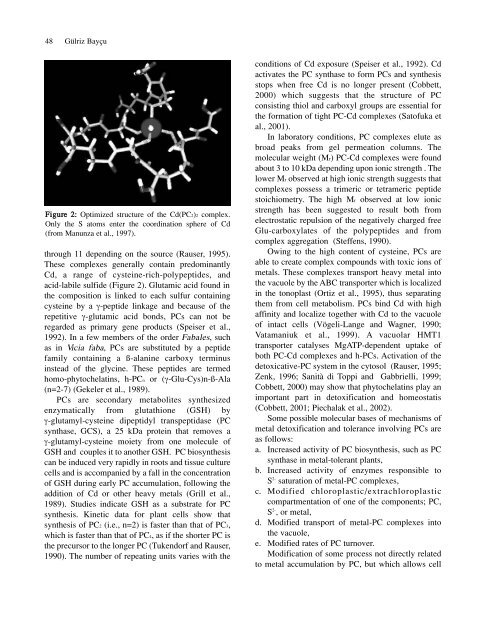Full Journal - Journal of Cell and Molecular Biology - Haliç Üniversitesi
Full Journal - Journal of Cell and Molecular Biology - Haliç Üniversitesi
Full Journal - Journal of Cell and Molecular Biology - Haliç Üniversitesi
Create successful ePaper yourself
Turn your PDF publications into a flip-book with our unique Google optimized e-Paper software.
48 Gülriz Bayçu<br />
Figure 2: Optimized structure <strong>of</strong> the Cd(PC2)2 complex.<br />
Only the S atoms enter the coordination sphere <strong>of</strong> Cd<br />
(from Manunza et al., 1997).<br />
through 11 depending on the source (Rauser, 1995).<br />
These complexes generally contain predominantly<br />
Cd, a range <strong>of</strong> cysteine-rich-polypeptides, <strong>and</strong><br />
acid-labile sulfide (Figure 2). Glutamic acid found in<br />
the composition is linked to each sulfur containing<br />
cysteine by a γ-peptide linkage <strong>and</strong> because <strong>of</strong> the<br />
repetitive γ-glutamic acid bonds, PCs can not be<br />
regarded as primary gene products (Speiser et al.,<br />
1992). In a few members <strong>of</strong> the order Fabales, such<br />
as in Vicia faba, PCs are substituted by a peptide<br />
family containing a ß-alanine carboxy terminus<br />
instead <strong>of</strong> the glycine. These peptides are termed<br />
homo-phytochelatins, h-PCn or (γ-Glu-Cys)n-ß-Ala<br />
(n=2-7) (Gekeler et al., 1989).<br />
PCs are secondary metabolites synthesized<br />
enzymatically from glutathione (GSH) by<br />
γ-glutamyl-cysteine dipeptidyl transpeptidase (PC<br />
synthase, GCS), a 25 kDa protein that removes a<br />
γ-glutamyl-cysteine moiety from one molecule <strong>of</strong><br />
GSH <strong>and</strong> couples it to another GSH. PC biosynthesis<br />
can be induced very rapidly in roots <strong>and</strong> tissue culture<br />
cells <strong>and</strong> is accompanied by a fall in the concentration<br />
<strong>of</strong> GSH during early PC accumulation, following the<br />
addition <strong>of</strong> Cd or other heavy metals (Grill et al.,<br />
1989). Studies indicate GSH as a substrate for PC<br />
synthesis. Kinetic data for plant cells show that<br />
synthesis <strong>of</strong> PC2 (i.e., n=2) is faster than that <strong>of</strong> PC3,<br />
which is faster than that <strong>of</strong> PC4, as if the shorter PC is<br />
the precursor to the longer PC (Tukendorf <strong>and</strong> Rauser,<br />
1990). The number <strong>of</strong> repeating units varies with the<br />
conditions <strong>of</strong> Cd exposure (Speiser et al., 1992). Cd<br />
activates the PC synthase to form PCs <strong>and</strong> synthesis<br />
stops when free Cd is no longer present (Cobbett,<br />
2000) which suggests that the structure <strong>of</strong> PC<br />
consisting thiol <strong>and</strong> carboxyl groups are essential for<br />
the formation <strong>of</strong> tight PC-Cd complexes (Sat<strong>of</strong>uka et<br />
al., 2001).<br />
In laboratory conditions, PC complexes elute as<br />
broad peaks from gel permeation columns. The<br />
molecular weight (Mr) PC-Cd complexes were found<br />
about 3 to 10 kDa depending upon ionic strength . The<br />
lower Mr observed at high ionic strength suggests that<br />
complexes possess a trimeric or tetrameric peptide<br />
stoichiometry. The high Mr observed at low ionic<br />
strength has been suggested to result both from<br />
electrostatic repulsion <strong>of</strong> the negatively charged free<br />
Glu-carboxylates <strong>of</strong> the polypeptides <strong>and</strong> from<br />
complex aggregation (Steffens, 1990).<br />
Owing to the high content <strong>of</strong> cysteine, PCs are<br />
able to create complex compounds with toxic ions <strong>of</strong><br />
metals. These complexes transport heavy metal into<br />
the vacuole by the ABC transporter which is localized<br />
in the tonoplast (Ortiz et al., 1995), thus separating<br />
them from cell metabolism. PCs bind Cd with high<br />
affinity <strong>and</strong> localize together with Cd to the vacuole<br />
<strong>of</strong> intact cells (Vögeli-Lange <strong>and</strong> Wagner, 1990;<br />
Vatamaniuk et al., 1999). A vacuolar HMT1<br />
transporter catalyses MgATP-dependent uptake <strong>of</strong><br />
both PC-Cd complexes <strong>and</strong> h-PCs. Activation <strong>of</strong> the<br />
detoxicative-PC system in the cytosol (Rauser, 1995;<br />
Zenk, 1996; Sanità di Toppi <strong>and</strong> Gabbrielli, 1999;<br />
Cobbett, 2000) may show that phytochelatins play an<br />
important part in detoxification <strong>and</strong> homeostatis<br />
(Cobbett, 2001; Piechalak et al., 2002).<br />
Some possible molecular bases <strong>of</strong> mechanisms <strong>of</strong><br />
metal detoxification <strong>and</strong> tolerance involving PCs are<br />
as follows:<br />
a. Increased activity <strong>of</strong> PC biosynthesis, such as PC<br />
synthase in metal-tolerant plants,<br />
b. Increased activity <strong>of</strong> enzymes responsible to<br />
S 2- saturation <strong>of</strong> metal-PC complexes,<br />
c. Modified chloroplastic/extrachloroplastic<br />
compartmentation <strong>of</strong> one <strong>of</strong> the components; PC,<br />
S 2- , or metal,<br />
d. Modified transport <strong>of</strong> metal-PC complexes into<br />
the vacuole,<br />
e. Modified rates <strong>of</strong> PC turnover.<br />
Modification <strong>of</strong> some process not directly related<br />
to metal accumulation by PC, but which allows cell

















